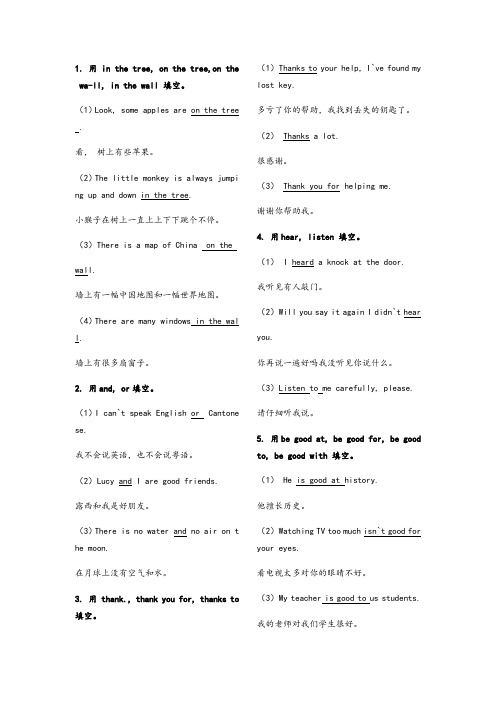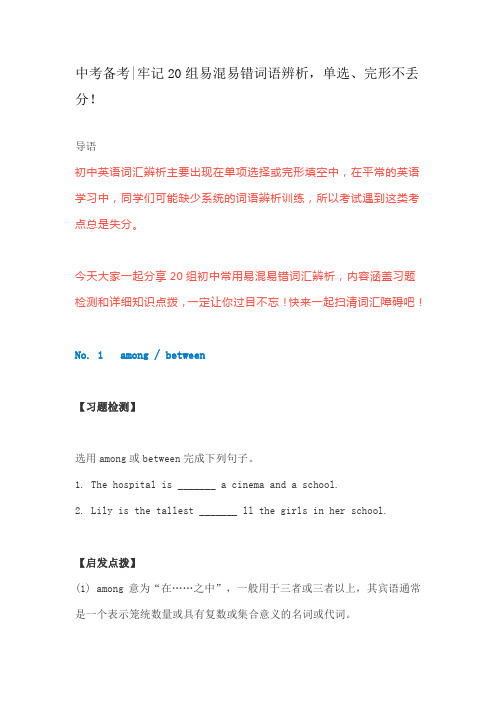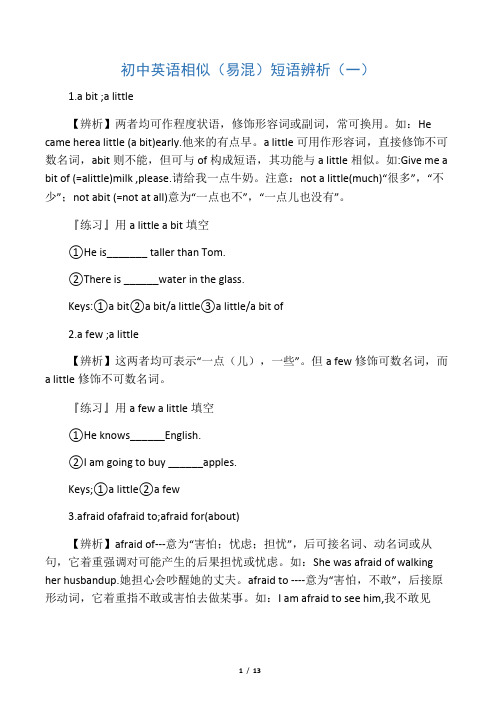初中英语易混词辨析
英语初中常用易混淆单词词组的区别用法

中考初中英语常用易混淆单词词组的区别用法英语常用易混淆单词/词组的区别用法一、how much和how many的区别用法how much和how many的区别:how much用来询问事物的数量,后接不可数名词;how many用来询问事物的数量,后接可数名词复数。
how much和how many的区别1、所修饰词不同how much用来修饰不可数名词,表示数量,也可单独使用。
how many用来修饰可数名词的复数,它的句式是:How many+复数名词+一般疑问句+?例句:How much milk is there in the glass?玻璃杯里有多少牛奶?How many books are there on the desk?有多少本书在桌子上?2、用法不同How much 表示多少钱,用来问价格。
例句:How much is this dress?这个连衣裙多少钱?How many 表示多少,用来问数量。
例句:How many apples do you have?你有多少苹果?二、in和on的区别用法当我们表示某些东西被其他东西所包围时使用“in”这个词。
而“on”用于描述物体被放置在其他物体上方或外部的情况。
in可表时间,表地点,表手段、方法、材料。
on表示时间、地点、方位等。
in和on区别一、意思不同in:prep. 在 ... 里;在 ... 地方;在 ... 期间on:prep. 在 ... 之上二、用法不同in: in着重一段时间的过程,常用于重复动作或延续动作。
in表示从现在时间算起推移到将来的一段时间之后,一般与将来时态连用。
例句:He is a layman in economics.他对经济学一窍不通。
on:表示“在物体的表面上”,只能用on的表达方式有on the next morning,on the following。
例句:The spider is walking on the ceiling.蜘蛛在天花板上爬行。
初中英语自诊断易混词辨析系列custom,costume,consume

初中英语⾃诊断易混词辨析系列custom,costume,consume易混词辨析是初中阶段的⼀个重点,同学们在平时的学习过程中如果能养成每学到⼀个新词就把它和之前学过的,考试中见到的跟这个词拼写相像或意思相同的单词短语放在⼀起对⽐记忆的话,我们就能对这些相似词印象更加深刻且不易忘记,长期坚持下去,词汇量必有⼤幅度的提升。
《初中英语⾃诊断》这本书的词汇部分,就给同学们整理了很多易混词,同学们课下要结合视频着重理解记忆。
customer n. 顾客辨析 custom customer costume consume consumercustom n. 习惯,习俗; 海关customer n. 顾客costume n. 戏服consume v. 消费,消耗consumer n. 消费者初中英语⾃诊断易混词辨析系列custom,costume,consumeIt is the custom in that country for women to marry young.⼥⼦早婚是那个国家的风俗。
The custom officer looked at the stamp in his passport.海关⼈员看了看他护照上的盖印。
She has four costume changes during the play.她在这出戏⾥要换四次服装。
Consumers will only consume more if they see their future income and purchasing powerrising.消费者只有看到未来收⼊和购买⼒上升,才会更多地消费。
初中英语⾃诊断易混词辨析系列custom,costume,consume很多学⽣和家长或许觉得纳闷,为啥班⾥的英语学霸单词记得那么牢固呢?我怎么过段时间就忘了呢?学霸们不会告诉您他们课后记单词的诀窍。
学霸们会对照着记单词,把拼写相近、意思接近的词汇与短语放到⼀起来背。
初中英语易混词、短语辨析

1. 用 in the tree, on the tree,on the wa-ll, in the wall 填空。
(1)Look, some apples are on the tree .看,树上有些苹果。
(2)The little monkey is always jumpi ng up and down in the tree.小猴子在树上一直上上下下跳个不停。
(3)There is a map of China on thewall.墙上有一幅中国地图和一幅世界地图。
(4)There are many windows in the wal l.墙上有很多扇窗子。
2. 用and, or填空。
(1)I can`t speak English or Cantone se.我不会说英语,也不会说粤语。
(2)Lucy and I are good friends.露西和我是好朋友。
(3)There is no water and no air on t he moon.在月球上没有空气和水。
3. 用 thank., thank you for, thanks to 填空。
(1)Thanks to your help, I`ve found my lost key.多亏了你的帮助,我找到丢失的钥匙了。
(2) Thanks a lot.很感谢。
(3) Thank you for helping me.谢谢你帮助我。
4. 用hear, listen 填空。
(1) I heard a knock at the door.我听见有人敲门。
(2)Will you say it again I didn`t hearyou.你再说一遍好吗我没听见你说什么。
(3)Listen to me carefully, please.请仔细听我说。
5. 用be good at, be good for, be good to, be good with 填空。
初中英语易混淆单词及短语简析

p se g r・ a sn es
A. o wih g t C.p a t ly wih
B.h l t ep wih D. a t de lwi h
A.p c p ik u
B.ma e u k p
C. e p g tu
D.s n p edu
“ 助某 人 ” 帮 之义 ;el i d a wt h是 “ 处理 , 付 , 对
涉及 ” 的含义 。
3 一 Mo . m,c n I a
— —
ቤተ መጻሕፍቲ ባይዱ
射, 使上 升 ” 的含义 。
t he TV?1wa tt n o
7 一 W h r r c o l lt e . o y u . e e a e my s h o oh s d o c
思。
6 .~ W h tr l o we h v n te hih y a u e d a e o h g wa ?
一
Bu o tt n h y tId n’ hi k te
c a! ot
h s n w i e
Bu e o c r a e s s r a s r no al we o t l o d t
【 解析 】 正确 的选择应 该是 A。owt g i h在这
儿是 “ … …相 配 , 跟 与… …相 伴” 的意思 ;l pa y wt i h的 意思 是 “ 玩弄 ,戏 耍 ”h l i :epwt h是
【 析 】A 为正 确 答 案 ,有 “ 车 接 载 解 用
( )拿 起 , 起 , 加 ( 人 , 捡 增 速度 ) 的 意思 ; a e ” m k u p有 “ 造 , 成 , 构 , 妆 ” 含 义 ;e 编 组 虚 化 的 gt u p有 “ 床 . 来 ” 意 思 : n p有 “ 起 起 的 s du e 发
英语中考牢记20组易混易错词语辨析

中考备考|牢记20组易混易错词语辨析,单选、完形不丢分!导语初中英语词汇辨析主要出现在单项选择或完形填空中,在平常的英语学习中,同学们可能缺少系统的词语辨析训练,所以考试遇到这类考点总是失分。
今天大家一起分享20组初中常用易混易错词汇辨析,内容涵盖习题检测和详细知识点拨,一定让你过目不忘!快来一起扫清词汇障碍吧!No. 1 among / between【习题检测】选用among或between完成下列句子。
1. The hospital is _______ a cinema and a school.2. Lily is the tallest _______ ll the girls in her school.【启发点拨】(1) among意为“在……之中”,一般用于三者或三者以上,其宾语通常是一个表示笼统数量或具有复数或集合意义的名词或代词。
(2) between一般指两者之间,其宾语通常是表示两者概念的名词或代词,或由and连接的两个具体的人或物。
between有时也可表示多者之中的“两两之间”。
如:Switzerland lies between France, Germany, Austria and Italy.Key:1. between2. amongNo. 2 lay / lie【习题检测】用lay或lie的适当形式完成句子。
1. I _______ the table when my mother cooked the meal.2. John was ill and _______ in bed all morning.【启发点拨】(1) lay作动词,可意为“摆放(餐桌)”,其过去式与过去分词均为laid,现在分词为laying,常用于短语lay the table,意为“摆放餐桌”。
如:Tom was laying the table.(2) lie作动词,意为“躺;平躺”时,过去式为lay,过去分词为lain,现在分词为lying。
初中英语常考易混介词用法辨析

初中英语常考易混介词用法辨析1.表示“大约”的about,around与or so*about表示“大约”时,常与较确定的数字连用,位于数词的前面,多用来表达时间、年龄和日期。
如:It’s about ten o’clock. 现在大约十点。
The girl is about ten years old.*around表示“大约”时,多用于美国英语,常与较确定的数字连用,位于数词的前面,通常用来表达时间、距离、重量、货币等。
如:I’ll be back at around 5 o’clock.The machine weighed around 30 pounds.The company has around $1.3 billion in debt.*or so意思是“大约、上下、左右、差不多”,放在数词的后面,表示时间、日期、数量等的约定范围。
如:We just walked a kilometer or so when it began to rain heavily.2.表示“关于”的about与on*about表示“关于、有关”,指内容较普通,通常涉及日常生产及生活等方面的事宜,侧重于叙事,即关于某方面的事情。
如:Tell him something about your trip.*on表示“关于”时,指严肃的、有研究性的、科研学术上的及国际形势、政治、理论、专著等方面的问题。
如:This is a book on radio.Next we’ll have a lesson on history.3.表示“在......上”的above,over与onabove“在......上方”,表示两者不接触与below(在......下面)相对在......上方在......上在......(正)上above on overbelow beneath under在......下面在......下在......下on“在......上面”,表示两者接触与beneath(在......下)相对over“在......(正)上方”,表示两者垂直,但不接触,也可指“笼罩或覆盖在上面”与under(在......下)相对*above表示“在......的上方”,指某物的位置高出某一物体或另一位置,两物之间不接触,反义词是below。
初中英语中常见的易混知识点

初中英语中常见的易混知识点易混知识点在初中英语学习中是常见的,因为它们经常会让学生感到困惑。
这些易混知识点涉及语法、词汇和说法等方面。
在本文中,我将列举一些常见的易混知识点并解释它们的区别,以帮助初中生更好地理解和应用它们。
一、a, an和thea和an都是不定冠词,表示单数不特指的人或物。
a用于以辅音音素开头的单词前,而an用于以元音音素开头的单词前。
例如,a book(一本书)和an apple (一个苹果)。
在此之后,我们使用定冠词the来指代特定的人或物。
例如,the book on the table(桌子上的那本书)。
二、there, their和they'rethere是副词,用于指示某处的位置。
例如,There is a cat in the garden(花园里有只猫)。
their是形容词,表示归属关系,意思是“他们的”。
例如,Their house is big(他们的房子很大)。
they're是they are的缩写形式,意思是“他们是”。
例如,They're my friends(他们是我的朋友)。
三、too, two和totoo是副词,意思是“也”,用于表示程度或数量过高。
例如,I am too tired to go (我太累了,无法去)。
two是数字2。
to是介词,用于表示方向、目的或比较。
例如,He went to the store(他去了商店)。
四、its和it'sits是形容词,表示归属关系,意思是“它的”。
例如,The cat licked its paws(猫舔了它的爪子)。
it's是it is的缩写形式,意思是“它是”。
例如,It's a beautiful day (今天是个美好的日子)。
五、your和you'reyour是形容词,表示归属关系,意思是“你的”。
例如,Is this your book?(这是你的书吗?)。
初中英语易错易混辨析归纳

易错易混辨析1. a bit 与a little①在肯定句中,a bit=a little,意为“有点儿”,修饰形容词或副词。
另外,a little还可以修饰不可数名词,意为“一点儿”。
Your article is a bit/a little long.There is only a little food left.②在否定句中,not a bit=not at all,意为“毫不”;not a little =very,意为“非常”。
The old man says that he is not a bit tired but in fact he is not a little tired.2.about与on都表示“关于”①about表示的内容较为普通,不是特别正式。
A book about Lei Feng②on表示严肃的或学术的A book on African history.3.above,on与over在......之上①表示位置高于某物(反below)Our office is above the shop.②表示物体表面相接触(反beneath)There is a glass on the desk.③表示垂直的上方(反under)There is a lamp hanging over the desk.4.accept与receive①表示主观上接受②表示客观上收到The girl received a gift,but she didn’t accept it.例题.I didn’t mean to trouble Curry yesterday. It was pouring with rain so I his offer of a lift. A.refused B.received C.allowed D.accepted5.across,throug与over①across在某个平面穿过②through从立体空间里穿过③over从上方越过The Great Wall winds its way from west to east ,across the deserts,over the mountains,through the valleys,till at last it reaches the sea.例题.You must be careful when you swim the lake.A.acrossB. belowC.overD.through6.ago与before①ago表示从事情发生到现在过去了多久(和一般过去时连用)②before表示从事情发生到过去某个时间是多久(可以和过去时或完成时连用)A week ago I went to see him ,but his father said that he had left two weeks before.7.agree with ,agree to 与agree on①agree with指“同意某人或某人的意见、观点、决定、想法、安排、解释”等,其后可以是一个名词或人称代词,也可以是what引导的从句。
初中英语易混词辨析

初中英语易混词辨析enjoy,like,love,preferenjoy,like,love和prefer都可表达“喜爱”的意思,但含义和用法有所不同。
enjoy在意义上侧重于“享受某种乐趣”,后接名词或动名词作宾语,不能接不定式。
enjoy还可以与反身代词连用,即“enjoy oneself”,表示“玩得很高兴”(= have a good time)The man is enjoying his dinner. 那个男人正津津有味地吃饭。
My father enjoys listening to the radio. 我父亲爱听广播。
Did the children enjoy themselves in the park? 孩子们在公园里玩得愉快吗?like意为“喜欢、喜爱”,是一般用语,主要是指对某人或某物产生好感或发生兴趣,不带有感情色彩,后面可接名词、代词、动名词、动词不定式作宾语。
Everyone in China likes Mid-Autumn Day. 在中国,每个人都喜欢中秋节。
He likes his students to work hard. 他喜欢他的学生努力学习。
love表示“爱、热爱、爱戴”,有强烈的感情,相当于like…very much,侧重于对祖国及较亲近的人的深厚感情。
在口语中它往往又指一般的喜爱,这时与like的意思相近,可以互换。
后面也可以接名词、动名词或动词不定式。
We love our motherland. 我们热爱我们的祖国。
They love playing/to play basketball. 他们爱打篮球。
like和love都可与would,should连用,表示“愿意做某事”。
I’d like/love to go with you. 我愿意和你们一起去。
prefer意为“(比较)喜欢、宁愿”,相当于like…better,它的“喜欢”是带有选择性的,是在比较的情况下选择出来的,其后接名词、代词、动名词或不定式。
易混动词辨析(初中英语专题复习)

易混动词辨析(初中英语专题复习)【易混辨析】【图解助记】cost /pay/ take /spend的区别:cost 的主语通常是事或物(包括形式主语it),不能是人;pay 的主语只能是人,常与for连用;spend 的主语也只能是人,构成spend on sth.或spend in doing sth.;take的主语常常是形式主语it。
如:The computer cost (me) $2000. 这台电脑花了(我) 2000 美元。
I have spent all day looking for you. 我花了一整天来找你。
It took him an hour to write the letter. 他写这封信花了一个小时。
She paid 10 yuan for this book. 她买这本书花了10元钱。
1.keep作及物动词,意为"使……保持(某种状态)"、"使得……"时,常用于以下几种结构:(1)keep+宾语(由人或物充当)+形容词。
Keep your hands clean. 手要保持干净。
(2)keep+宾语+副词。
What have kept you awa for so long? 什么事使你离开这么久?(3)keep+宾语+v-ing。
I’m sorry to have kept you waiting. 对不起,让你久等了。
(4)keep+宾语+v-ed。
Keep the door clsed. 让门关着。
(5)keep+宾语+介词短语。
Don’t keep your hands in your pockets. 不要把手插在口袋里。
2.keep作及物动词,后接名词作宾语,构成动宾结构,意为"保存"、"保留"、"记(日记等)"、"经营(商店等)"、"遵守(诺言等)"之意。
I keep a diary in English.我用英文记日记。
She keeps a bllkstore.她经营一家书店。
初中英语易混词辨析

初中英语易混词辨析-CAL-FENGHAI.-(YICAI)-Company One1中考易混淆的同义词总结1.say, speak, talk, tell这四个词都有“说”的意思,其用法差异主要在于各自强调的对象、内容不同。
(1)say的意思是“说”、“讲”、“说出”,是及物动词,强调“说”的内容。
不仅可指口头“说”,而且可指书面“说”。
eg: ① He said nothing to me. 他对我什么也没说。
② He said in his letter that he was getting on well with his life.他在信中说,他生活得很好。
固定搭配:say hello/good bye/sorry to sb. 向某人问候/告别/道歉say “ yes ” to sb . = agree with sb. 同意某人say “ no ” to sb. = disagree with sb. 不同意某人(2) speak表“说”、“讲”,它可以表示任何一种方式的“说话”。
它着重“说话”这一动作本身,而不强调所“说”的内容。
它通常为不及物动词,但它也可以作及物动词,后接the language、the truth、a word等,或接表示语言名称的名词。
eg: ①Please speak more slowly and clearly. 请说慢些和清楚些。
②Who is speaking 你是谁(打电话时用语)③Can you speak Japanese 你会讲日语吗固定搭配:speak to sb. 对某人说话speak highly of 称赞speak one’s mind 说心里话; 直言不讳(3) talk表示“交谈”、“谈话”,它指连贯地与人交谈,着重指说话的动作,而不强调说话的内容。
它一般用作不及物动词。
eg:①What are you talking about 你们在谈论什么②We are talking about the Chinese football match.我们在谈论中国足球比赛。
初中英语相似(易混)短语辨析

初中英语相似(易混)短语辨析(一)1.a bit ;a little【辨析】两者均可作程度状语,修饰形容词或副词,常可换用。
如:He came herea little (a bit)early.他来的有点早。
a little可用作形容词,直接修饰不可数名词,abit则不能,但可与of构成短语,其功能与a little相似。
如:Give me a bit of (=alittle)milk ,please.请给我一点牛奶。
注意:not a little(much)“很多”,“不少”;not abit (=not at all)意为“一点也不”,“一点儿也没有”。
『练习』用a little a bit填空①He is_______ taller than Tom.②There is ______water in the glass.Keys:①a bit②a bit/a little③a little/a bit of2.a few ;a little【辨析】这两者均可表示“一点(儿),一些”。
但a few修饰可数名词,而a little修饰不可数名词。
『练习』用a few a little填空①He knows______English.②I am going to buy ______apples.Keys;①a little②a few3.afraid ofafraid to;afraid for(about)【辨析】afraid of---意为“害怕;忧虑;担忧”,后可接名词、动名词或从句,它着重强调对可能产生的后果担忧或忧虑。
如:She was afraid of walking her husbandup.她担心会吵醒她的丈夫。
afraid to ----意为“害怕,不敢”,后接原形动词,它着重指不敢或害怕去做某事。
如:I am afraid to see him,我不敢见他。
afraid for (about)意为“替某人(事)担心”,其后接人或事。
初中英语常见易混词汇辨析

初中英语常见易混词汇辨析在初中英语的学习中,同学们常常会遇到一些容易混淆的词汇,这些词汇在拼写、发音、词义或用法上有相似之处,给我们的理解和运用带来了一定的困难。
下面就为大家详细辨析一些常见的易混词汇。
一、“a”和“an”“a”和“an”都属于不定冠词,用于泛指一个人或事物。
“a”用于以辅音音素开头的单词前,“an”用于以元音音素开头的单词前。
需要注意的是,这里所说的“元音音素”和“辅音音素”指的是读音,而不是字母。
例如,“a book”(一本书),“an apple”(一个苹果)。
“hour”(小时)这个单词虽然以“h”开头,但“h”不发音,它的读音是以元音音素开头,所以应该说“an hour”。
二、“alone”和“lonely”“alone”表示“独自的,单独的”,侧重于指客观上的独自一人,没有同伴。
“lonely”则表示“孤独的,寂寞的”,侧重于指主观上感到孤独、寂寞,带有感情色彩。
例如,“He lives alone but he doesn't feel lonely”(他独自生活,但并不感到孤独。
)三、“bring”和“take”“bring”意为“带来,拿来”,指把某物从别处带到说话者所在的地方。
“take”意为“拿走,带走”,指把某物从说话者所在的地方带到别处。
例如,“Bring your book here”(把你的书带到这儿来。
)“Take this bag to your room”(把这个包拿到你的房间去。
)四、“in front of”和“in the front of”“in front of”表示“在……前面”,指在某个物体外部的前面。
“in the front of”也表示“在……前面”,但指在某个物体内部的前面。
例如,“There is a tree in front of the house”(房子前面有一棵树。
)“The driver is sitting in the front of the bus”(司机坐在公共汽车的前部。
初中英语语法——易混动词用法辨析

初中英语语法——易混动词用法辨析1.agree with,agree to和agree on*agree with...指“同意某人或某人的意见、观点、决定、方法、安排、说明”等,其后能够是一个名词,也能够是what引起的从句。
如:I don’t agree with you.I don’t agree with what you said.*agree to...是指“同意某打算、建议、或建议”等;后跟动词原形,意为“同意干某事”。
如:Who else will agree to this suggestion besides him?We agreed to start early.*agree on...指在某方面取得一致的看法或意见。
如:We agree on leaving for Beijing the next day.2.answer和reply*answer是常用词,可指口头、笔头,甚至行动回答,有时可与reply 通用。
如:Who can answer the question?Please answer the telephone.*reply较answer正式,既可指用语言、书面作答,也可指用动作或手势作答,常用于正式场合或书面语中,指通过慎重考虑作出的答复。
如:I sent in my application,and the school replied immediately.3.apologize to和apologize for*apologize to sb.相当于say sorry to sb. 表示“向某人道歉”。
如:You should apologize to the old man.*apologize for sb.意为“替某人道歉或认错”。
如:4.argue about和argue with*argue about指“为某事而争辩、争吵”。
如:Don’t argue about the matter any more.*argue with指“为某人争吵、争辩或吵架”。
初中英语易混动词辨析

易混动词及短语动词1.beat和win的区别beat表示“打败”,后面跟的宾语是对手;win表示“赢得”,后面跟比赛或活动等作宾语。
如:They beat the Giants by a score of 7 to 3. 他们以7比3战胜了巨人队。
Though it was not easy, they won the game at last. 虽然不容易,他们最后还是赢了比赛。
2.carry, take与bring的区别take是指将某物或某人从这里“带到”或“拿到”某处。
bring与take相反,是指将某物或某人从别处“带来”或“拿来”。
carry是指随身携带(背着、扛着、提着、抱着),不表明来去的方向。
fetch常指从说话地到另外一个地店,取回某物。
如:Please help me take it to the classroom. 请帮我把它拿到教室去。
May I bring Tom to see you next Monday? 我下周一能带Tom来见你吗?The box is heavy. Can you carry it? 这个盒子太重了,你能拿得起来吗?Fetch a glass of water for me, please. 请给我拿杯水来。
3.cross和across的区别cross与across都表示“穿过;横过"的意思。
但是cross 是及物动词,across是介词,across 是前面必须还要有谓语动词。
如:Is it safe to cross the road now? 现在过马路安全吗?Go across the bridge. You'll find the museum on the left. 走过这座桥,你就会在左边找到那个博物馆。
4.hear与listen to的区别动词hear与listen to之间的区别,同see与look at之间的区别非常相似。
- 1、下载文档前请自行甄别文档内容的完整性,平台不提供额外的编辑、内容补充、找答案等附加服务。
- 2、"仅部分预览"的文档,不可在线预览部分如存在完整性等问题,可反馈申请退款(可完整预览的文档不适用该条件!)。
- 3、如文档侵犯您的权益,请联系客服反馈,我们会尽快为您处理(人工客服工作时间:9:00-18:30)。
初中英语易混词辨析.中考常考同义词或词组同近义词或词组的辨析题,不仅在平时测验、周考、月考中常出,也是中考的一个重要考察点,平时我们就应该注意这些词的不同用法以及一些固定搭配,这样不仅对平时成绩有帮助,也会在中考时起一定的作用,下面我们就逐步的总结一下这些重要的常考的同近义词:1.spend, pay, cost, take(1) spend vt. “花费”,主语只能是人;常用结构:sb. spend 时间/钱 on sth. “在…上花时间/金钱sb. spend 时间/钱 (in) doing sth. “在做某事上花费时间/金钱”eg: I spend two hours on my homework every day.=I spend two hours (in) doing my homework every day.spend 还有“度过”的意思。
此外,※常用结构:with sb.spend…。
's friends“和朋友一起度假”eg: spend one's holiday with one (2) pay vt. & vi. “花费,付款”,主语只能是人;常用结构:“某人为某物付钱” sb. pay 钱 for sth.“某人付钱给某人”= sb. pay钱 to sb. 钱sb, pay sb.我们必须付他10美元。
eg: We must pay him 10 dollars.= She paid 100 dollars for her new shoes.,主语是物,(3) cost vt.“花费”常用结构:sth. cost sb钱“某物花费某人多少钱”- 2 -eg: This dictionary cost me 50 yuan.=I spent 50 yuan on this dictionary.=I paid 50 yuan for this dictionary.※此外,cost还有“值多少钱”的意思。
常用结构:sth. cost 钱eg: This book cost 20 yuan. 这本书值20元钱。
※ cost 还可作名词,“成本,费用”。
固定搭配:at all costs 不惜任何代价,无论如何eg: I'll do it well at all costs. 无论如何我都要把这件事做好。
※※ cost 的过去式是本身,做题时一定要注意句子是什么时态,前后搭配要一致。
常见的过去式是本身的动词:cost, put, cut, read(4) take 当“花费”讲时,主语是物,常用结构:It takes sb.时间/钱 to do sth.eg: It took me two hours to write this composition.= I spend two hours (in) writing this composition.2.arrive, get to, reach(1) 这三个词都有“到达”的意思,但arrive为不及物动词,后接地点名词时要加介词,reach和get to后面直接跟表示地点的名词,常用结构:arrive in + 大地方(名词)arrive at + 小地方(名词)get to + 地点(名词)reach + 地点(名词)Eg: arrive in Beijing = get to Beijing = reach Beijing- 3 -Arrive at the station = get to station = reach the starion※ (2) arrive 和 get to 后接地点副词时,arrive后不加介词,get to 去掉to,Eg: arrive home/here/there = get home/here/there※初中常见的地点副词有home, here, there.※※三者只有arrive可以不加地点。
如:“我们明天到”,只能用 We will arrive tommorrow.3.wear, put on, dress, have on, be in, be dressed input on 和 dress 表穿动作,其他的都表示状态。
(1) put on “穿上,戴上”,宾语是衣服、鞋帽等,※宾语为代词时,要放在put on之间,如:put them on, put it on. eg: It's very cold outside. Please put on your overcoat.※※反义短语为take off,注意一定不是put off.(2) wear 常指“穿着”、“戴着”的状态,宾语是衣服、鞋帽等。
它还有“留(长发),蓄(胡子)”等意思,eg: wear blue shoes/glasses/a new hat/a watch/new clothes (3) dress + sb. / oneself “给某人穿衣服”,宾语不能是“衣服”,只能是“人”,eg: The mother dresses her baby every morning.(4)have on 指状态,不用进行时,因为它本身就有进行时的含义:“有…在身上”,eg: He always has his cap on, 他总是戴着帽子。
(5)be in, be dressed in 后面不仅可接“衣服”,还可接“颜色”,这是与前面几个词和短语的用法不同的。
eg: She is always (dresses) in red. 她总穿红衣服。
4.few, a few, little, a little, a bit, a bit of这几个词分成几对来比较:(1) a few few- 4 -littlea little)( 只能横向比较和竖向比较表肯定“有一点”,有①few 和 a few后面都接可数名词的复数形式,a的表示,表否定;没有a的表示“几乎没有”的后接不可数名词,有a的表示“有一点”,表肯定;没有a②little 和 a little表示“几乎没有”,表否定;Eg: hurry up. There is little time left, 快点,没有时间了。
Don't worry. There is still a little time left.别着急,还有一点时间。
He has few friends, so he is very lonely.他几乎没有朋友,所以他感到很孤独。
注意: only a little = littleonly a few = few当 a few 前有另一个形容词或定冠词修饰时,a 要去掉。
Eg: in the past few years . 在过去的几年中。
Every few hundred meters 每隔几百米。
(2) a little,a bit,a little bit, a bit of① a little,a bit与a little bit修饰形容词和副词时,基本可以互换,只是a littlebit的语气比前两者弱;Eg: I am a little tired. = I am a bit tired. 我有一点累。
注意:a little 还可以修饰比较级,a bit 则不能。
(修饰比较级的其他词:much, even, a little, a lot ,far ,any) Eg: She is a little taller than me. 她比我高一点。
※② a bit of 修饰不可数名词,a bit 不可以修饰名词;修饰名词时:a little + 不可数名词= a bit of + 不可数名词表达否定时:not a bit = not at all “一点也不”- 5 -“十分,相当” Not a little = quiteEg: She is not a bit tired. (=She is not tired at all.) 她一点都不累。
她很累She is not a little tired.too many, too much, much too5.,指超过了一定的限度,前者后接可数much 意为“太多”(1) too many 和too名词复数,后者接不可数名词,并且可以单独使用。
s singing competetion. Eg: Too many people took part in yesterday' 太多的人参加了昨天的歌唱比赛。
I am sorry. I have given you too much trouble.对不起,我给你添了太多的麻烦。
他吃得太多了。
He ate too much.,后接形容词或副词。
(2) much too意为“太…,非常…”Eg: The shoes are much too large for me.这鞋我穿起来实在是太大了。
He ran much too fast.他跑得太快了。
(太);均以词组中的后一个词为主,即much too的重心是too 注意:这三个词组,,区别在于名词可的重心也是(多)(多),too many muchtoo much 的重心是不可数,所以我们做题时只看后面修饰的是什么词就可以了。
这一用法。
没有many too ※※have to, must6.;(1) have to 表示由于客观环境或条件的要求而“必须,不得不”表示说话人的主观要求和看法;musts time for class now. I have to go. Eg: It' 上课时间到了,我不得不走了。
I must go home now. 我现在必须回家绝不可”“禁止,must 而“不必”(2) have to 的否定式式的意思;的否定式是- 6 -的意思,两者大不相同;t have to hand in your homework today, Eg: You don'你们不必今天交家庭作业。
't have to)'t be late. 你绝不能迟到。
(不用 don You musten 不能;可表示推测,用在肯定句中,译成“一定”;have to (3) must他一定生病了。
Eg: He must be ill.你当时一定知道这个消息。
You must have known the news. 则无时态变化。
有时态变化,must (4) have to(将来时)' ll have to see doctor. Eg: If you are ill, you 如果你生病了,你就得去看医生。
